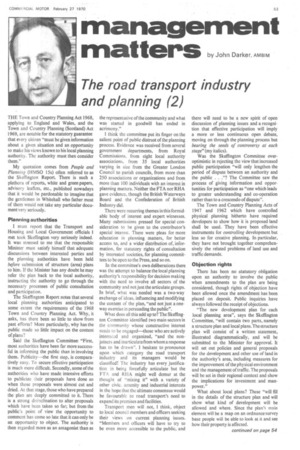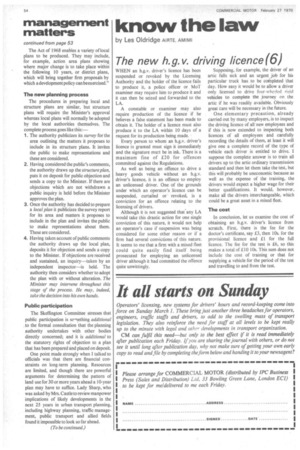management
Page 55

Page 56

If you've noticed an error in this article please click here to report it so we can fix it.
matters by John Darker. AMBIM
The road transport industry and planning (2)
THE Town and Country Planning Act 1968, applying to England and Wales, and the Town and Country Planning (Scotland) Act 1969, are notable for the statutory guarantee that every citizen "must be given information about a given situation and an opportunity to make his views known to his local planning authority. The authority must then consider them."
My quotation comes from People and Planning (HMSO 15s) often referred to as the Skeffington Report. There is such a plethora of reports, white and green papers, advisory leaflets, etc., published nowadays that it would be pardonable to imagine that the gentlemen in Whitehall who father most of them would not take any particular document very seriously.
Planning authorities
I must report that the Transport and Housing and Local Government officials I met took Skeffington very seriously indeed. It was stressed to me that the responsible Minister must satisfy himself that adequate discussions between interested parties and the planning authorities have been held before submission of structure (area) plans to him. If the Minister has any doubt he may refer the plan back to the local authority, instructing the authority to go through the necessary processes of public consultation and participation.
The Skeffington Report notes that several local planning authorities anticipated to some extent the requirements of the 1968 Town and Country Planning Act. Why, it asks, has there been so little to show from past efforts? More particularly, why has the public made so little impact on the content of plans ?
, Said the Skeffington Committee: "First, most authorities have been far more successful in informing the public than in involving them. Publicity—the first step, is comparatively easy. To secure effective participation is much more difficult. Secondly, some of the authorities who have made, intensive efforts to publicize their proposals have done so when those proposals were almost cut and dried. At that stage, those who have prepared the plan arc deeply committed to it. There is a strong disinclination to alter proposals which have been taken so far; but from the public's point of view the opportunity to comment has come so late that it can only be an opportunity to object. The authority is then regarded more as an antagonist than as the representative of the community and what was started in goodwill has ended in acrimony," I think the committee put its finger on the salient point of public distrust of the planning process. Evidence was received from several government departments, from Royal Commissions, from eight local authority associations, from 35 local authorities varying in size from the Greater London Council to parish councils, from more than 250 associations or organizations and from more than 100 individuals with an interest in planning matters. Neither the FTA nor RHA gave evidence, though the British Waterways Board and the Confederation of British Industry did.
There were recurring themes in this formidable body of interest and expert witnesses. Many submissions pressed for special consideration to be given to the contributor's special interest. There were pleas for more education in planning matters, for better access to, and a wider distribution of, information, for statutory rights of consultation by interested societies, for planning committees to be open to the Press, and so on.
In the committee's own deliberations there was the attempt to balance the local planning authority's responsibility for decision making with the need to involve all sectors of the community and not just the articulate groups. In brief, what was needed was a two-way exchange of ideas, influencing and modifying the content of the plan, "and not just a oneway exercise in persuading the public".
What does all this add up to? The Skeffington Committee identified two main sectors in the community whose constructive interest needs to be engaged—those who are actively interested and organized, "and the nonjoiners and inarticulate from whom a response has to be drawn". I hesitate to pronounce upon which category the road transport industry and its managers would be classified! The industry has every justification in being forcefully articulate but the ETA and RUA might well demur at the thought of "mixing it" with a variety of other civic, amenity and industrial interests in the hope that the ultimate consensus would be favourable to road transport's need to expand its premises and facilities.
Transport men will not, I think, object to local council members and officers seeking their views on current planning issues. "Members and officers will have to try to be even more accessible to the public, and
there will need to be a new spirit of open discussion of planning issues and a recognition that effective participation will imply a more or less continuous open debate, moving on through the planning process but bearing the seeds of controversy at each stage" (my italics).
Was the Skeffington Committee overoptimistic in rejecting the view that increased public participation "will only lengthen the period of dispute between an authority and the public . ."? The Committee saw the process of giving information and opportunities for participation as "one which leads to greater understanding and co-operation rather than to a crescendo of dispute".
The Town and Country Planning Acts of 1947 and 1962 which have controlled physical planning hitherto have required developers to show how it is proposed land shall be used. They have been effective instruments for controlling development but less so for creative planning. In particular, they have not brought together comprehensively the related problems of land use and traffic demands.
Objection rights There has been no statutory obligation upon an authority to involve the public when amendments to the plan are being considered, though rights of objection have been allowed once the amendment has been placed on deposit. Public inquiries have always followed the receipt of objections.
"The new development plan for each local planning area", says the Skeffington Committee, "will contain two parts, namely a structure plan and local plans. The structure plan will consist of a written statement, illustrated diagrammatically, and will be submitted to the Minister for approval. It will set out policies and general proposals for the development and other use of land in the authority's area, including measures for the improvement of the physical environment and the management of traffic. The proposals will be set in their regional context and show the implications for investment and manpower."
What about local plans? These "will fill in the details of the structure plan and will show what kind of development will be allowed and where. Since the plan's main element will be a map on an ordnance survey base people will be able to look at it and see how their property is affected. The Act of 1968 enables a variety of local plans to be produced. They may include, for example, action area plans showing where major change is to take place within the following 10 years, or district plans, which will bring together firm proposals by which a development policy can beexercised."
The new planning process The procedures in preparing local and structure plans are similar, but structure plans will require the Minister's approval whereas local plans will normally be adopted by the local authorities themselves. The complete process goes like this:
1. The authority publicizes its survey for the area outlining the matters it proposes to include in its structure plans. It invites the public to make representations and these are considered.
2. Having considered the public's comments, the authority draws up the structure plan, puts it on deposit for public objection and sends a copy to the Minister. If there are objections which are not withdrawn a public inquiry is held before the Minister approves the plan.
3. Once the authority has decided to prepare a local plan it publicizes the survey report for its area and matters it proposes to include in the plan and invites the public to make representations about them. These are considered.
4. Having taken account of public comments the authority draws up the local plan, deposits it for objection and sends a copy to the Minister. If objections are received and sustained, an inquiry—taken by an independent inspector—is held. The authority then considers whether to adopt the plan with or without alteration. The Minister may intervene throughout this stage of the process. He may, indeed, take the decision into his own hands.
Public participation
The Skeffington Committee stresses that public participation is something additional to the formal consultation that the planning authority undertakes with other bodies directly concerned; and it is additional to the statutory rights of objection to a plan that has been prepared and placed on deposit.
One point made strongly when I talked to officials was that there are financial constraints on long-term planning. Resources are limited, and though there are powerful arguments for determining the pattern of land use for 30 or more years ahead a 10-year plan may have to suffice. Lady Sharp, who was asked by Mrs. Castle to review manpower implications of likely developments in the next 25 years in urban transport planning, including highway planning, traffic management, public transport and allied fields found it impossible to look so far ahead.




































































































